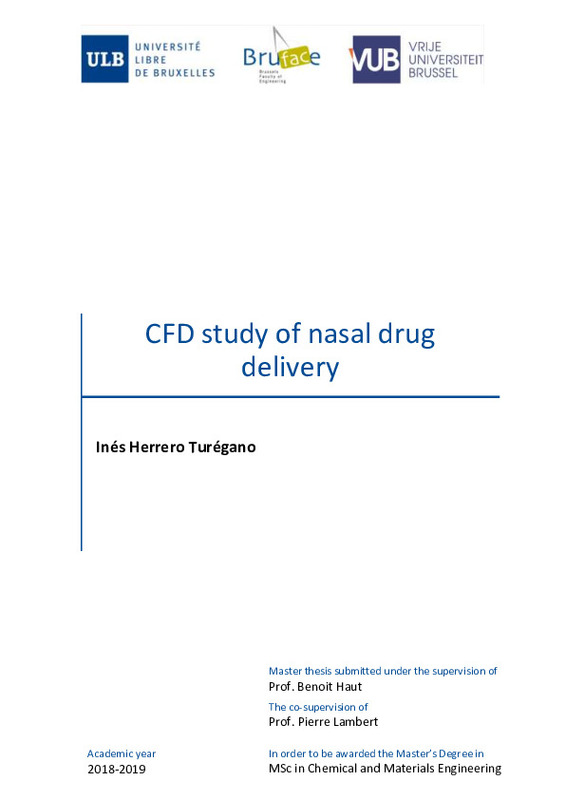JavaScript is disabled for your browser. Some features of this site may not work without it.
Buscar en RiuNet
Listar
Mi cuenta
Estadísticas
Ayuda RiuNet
Admin. UPV
Estudio CFD de la entrega de medicamentos por vía nasal
Mostrar el registro sencillo del ítem
Ficheros en el ítem
| dc.contributor.advisor | Santafé Moros, María Asunción
|
es_ES |
| dc.contributor.author | Herrero Turégano, Inés
|
es_ES |
| dc.date.accessioned | 2020-06-08T18:13:10Z | |
| dc.date.available | 2020-06-08T18:13:10Z | |
| dc.date.created | 2019-09-30 | |
| dc.date.issued | 2020-06-08 | es_ES |
| dc.identifier.uri | http://hdl.handle.net/10251/145698 | |
| dc.description.abstract | [EN] In the last decades, the increasing number of neurodegenerative diseases have alerted the scientific community. The diagnosis of Alzheimer disease is supposed to double the number every 20 years, reaching the 131,5 million by 2050. Some studies have shown a relation between the loss of smell and the appearance of these kinds of neurodegenerative diseases. For this reason, the nasal cavity is considered a potential pathway to treat the disease since the olfactory epithelium offers a direct connection to the brain. In addition, nasal delivery overcomes some of the limitations that oral and parental techniques involve such as a slower delivery process to the brain, low concentration of the drug in the brain due to the existence of a blood brain barrier or a low bioavailability of the drug in the brain. In this context, the aim of this thesis is to study the air flow behaviour of human breathing in the nasal cavity by using a computational fluid dynamics (CFD) simulating software, ANSYS Fluent. The aim of these simulations is to obtain an accurate description of the airflow behaviour in order to know which areas of the nasal cavity are more exposed to the drug effects. Different real situations are simulated: normal human breathing, strong conditions of human breathing like the action of sniffing drugs and lastly the particle’s injection. From this study, future research can be developed to maximize the nasal drugs delivery in some locations by varying the formulation of the drug or the administration technique. | es_ES |
| dc.description.abstract | [ES] El suministro intranasal de medicamentos ha atraído una atención significativa debido a la oportunidad de administrar medicamentos sistémicos directamente al torrente sanguíneo. El siguiente proyecto se compromete a estudiar el comportamiento del flujo 3-D en el suministro de medicamentos desde la nariz al cerebro mediante el uso de un software de simulación de dinámica de fluidos, ANSYS Fluent. El yeso nasal utilizado se ha proporcionado a partir de una tomografía computarizada (TC) de personas reales, estas tomografías se han convertido a un archivo stl. para poder ser importado en Workbench. Las condiciones de la entrega de medicamentos se modificarán para estudiar cuáles son los parámetros óptimos de inyección para lograr un resultado eficiente. | es_ES |
| dc.language | Inglés | es_ES |
| dc.publisher | Universitat Politècnica de València | es_ES |
| dc.rights | Reserva de todos los derechos | es_ES |
| dc.subject | Cavidad nasal | es_ES |
| dc.subject | CFD | es_ES |
| dc.subject | Ansys Fluent | es_ES |
| dc.subject | Entrega de medicamentos | es_ES |
| dc.subject | Nasal Cavity | es_ES |
| dc.subject | Drug's delivery | es_ES |
| dc.subject.classification | INGENIERIA QUIMICA | es_ES |
| dc.subject.other | Máster Universitario en Ingeniería Química-Màster Universitari en Enginyeria Química | es_ES |
| dc.title | Estudio CFD de la entrega de medicamentos por vía nasal | es_ES |
| dc.type | Tesis de máster | es_ES |
| dc.rights.accessRights | Abierto | es_ES |
| dc.contributor.affiliation | Universitat Politècnica de València. Departamento de Ingeniería Química y Nuclear - Departament d'Enginyeria Química i Nuclear | es_ES |
| dc.contributor.affiliation | Universitat Politècnica de València. Escuela Técnica Superior de Ingenieros Industriales - Escola Tècnica Superior d'Enginyers Industrials | es_ES |
| dc.description.bibliographicCitation | Herrero Turégano, I. (2019). Estudio CFD de la entrega de medicamentos por vía nasal. http://hdl.handle.net/10251/145698 | es_ES |
| dc.description.accrualMethod | TFGM | es_ES |
| dc.relation.pasarela | TFGM\113409 | es_ES |
Este ítem aparece en la(s) siguiente(s) colección(ones)
-
ETSII - Trabajos académicos [10404]
Escuela Técnica Superior de Ingenieros Industriales







